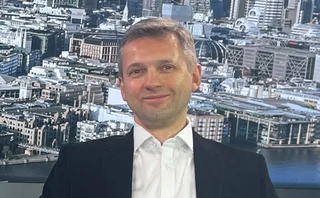
Podcast: Lyashenko, Mercurio and Sokol’s adventures in autoencoding
Trio of senior quants explain how autoencoders can reduce dimensionality in yield curves

Any quant will tell you that modelling multiple yield curves is no easy task. Most fixed income instruments have numerous term structures, each with 10–15 maturities, that share a hard-to-model, non-linear co-dependence structure.
Two years ago, a trio of quants set out to simplify the problem using autoencoders, a type of generative neural network.
In this episode of Quantcast, they discuss their solution, which was published in Risk.net earlier this month.
The technique can be compared to compression algorithms that are used to reduce the size of files, such as digital images. But unlike standard compression algorithms, autoencoders provide a compression that is specific to a dataset. This makes them much more powerful, says Alexander Sokol, founder and head of quant research at CompatibL – one of the authors of the paper – and well-suited to reducing the dimensionality of yields curves to a handful of variables, or factors.
The approach is built on the risk-neutral Q-measure and relied on historical data to derive the key factors that drive yield curves. The theoretical framework for this solution was previously published by another of the authors, Andrei Lyashenko, head of market pricing and risk models at QRM, and his colleague Yevgeny Goncharov in 2023.
As Fabio Mercurio, global head of quant analytics at Bloomberg and co-author of the paper, explains, this is a significant theoretical departure from parametric models, such as the ubiquitous Nelson-Siegel model, and other approaches such as principal component analysis.
“Compared to other existing approaches, our framework has the advantage that it is able to incorporate historical yield curve behaviour by construction,” says Mercurio. “We take the behaviour that we learn from the history through the autoencoder modelling and we insert that behaviour mathematically into our framework.”
This, he says, allows the algorithm to produce more realistic yields curves and, by extension, cheaper hedging strategies.
Under this approach, autoencoders are fed the full-dimensional representation of the yield curve. The encoder compresses the data into a small number of latent variables. Then, the decoder reproduces the yield curve from these variables. This process allows the model to learn the underlying structure of the data, capturing its essential features while discarding noise.
A key concept used in the paper is that of autoencoder manifolds – low-dimensional representations of the data fed to the model. The manifolds contain information on the relationships between the main points of a yield curve. “[What] we found is that when you build the model on the manifold, then you observe that … the curves you produce are automatically following these relationships,” says Sokol.
Another key element is the enforcement of arbitrage-free conditions, which proved to be a challenging exercise in this case. The data transformation involved in this approach makes it generally arbitrageable. To make the model arbitrage-free, constraints had to be enforced on the specification of volatility – a solution inspired by Lyashenko’s previous paper with Goncharov.
The authors see this framework as naturally applicable to the pricing of interest rate products such as swaptions, constant maturity swaps or spread options. It can also be used to hedge products exposed to the correlation between different rates.
Mercurio sees other uses beyond pricing and hedging of single instruments. “At portfolio level the applications are many,” he says. “For example, you can use this approach for portfolio valuation, but also simulation… XVA, scenario analysis and asset liability management.”
Seven-year itch
The foundations for the paper were laid by the authors themselves and others over the past seven years. Alexei Kondratyev, now a professor at Imperial College London, was the first to propose the use of autoencoders to model yield curves, an idea that gained him Risk.net’s award for quant of the year in 2018.
Sokol and Lyashenko have also made prior contributions to this stream of research. In 2022, Sokol investigated the optimal way to capture the state variables of yield curves using autoencoders and showed how they generated a low-dimensional representation of rates. And in 2023, Lyashenko and Goncharov introduced the innovative idea of a risk-neutral framework based on a factor representation. The most desirable features of that approach, namely ease of use and no-arbitrage, formed the basis of the latest paper.
But while Sokol and Lyashenko have been studying the use of autoencoders to model rates for some time, it was a 2023 presentation by Jesper Andreasen, head of quantitative analytics at Verition Fund Management, that brought them and Mercurio together. The trio were in the audience for Andreasen’s presentation, which provided empirical confirmation of the ideas expressed by Kondratyev years earlier were valid and close to arbitrage-free. That prompted the three of them to join forces to develop the idea further.
While previous uses of autoencoders were an intermediate step, generating outputs that had to be processed by a separate model to build yield curves, Lyashenko, Mercurio and Sokol show how autoencoders can directly extrapolate full yield curves. This, they explain in the podcast, is crucial for their arbitrage conditions to hold and, ultimately, for the framework to be implemented for pricing and hedging.
The next step is to put the framework into production. The authors concede more work must be done before their theoretical advances can be translated into real-world applications. Still, Sokol is confident CompatibL will have it in production soon. Lyashenko and Mercurio are more cautious on timing, but share Sokol’s optimism on future adoption.
Index
00:00 Introduction
02:12 Genesis of the project
06:45 Interest rate models
11:52 Factors that drive yield curves
14:06 Autoencoders and manifolds
21:48 No-arbitrage condition
32:38 A risk-neutral approach
36:06 An analogy to topology
42:12 Applications to rates and derivative portfolios
50:00 Roadmap for implementation
To hear the full interview, listen in the player above, or download. Future podcasts in our Quantcast series will be uploaded to Risk.net. You can also visit the main page here to access all tracks, or go to Spotify, Amazon Music or the iTunes store to listen and subscribe.
Only users who have a paid subscription or are part of a corporate subscription are able to print or copy content.
To access these options, along with all other subscription benefits, please contact info@risk.net or view our subscription options here: http://subscriptions.risk.net/subscribe
You are currently unable to print this content. Please contact info@risk.net to find out more.
You are currently unable to copy this content. Please contact info@risk.net to find out more.
Copyright Infopro Digital Limited. All rights reserved.
As outlined in our terms and conditions, https://www.infopro-digital.com/terms-and-conditions/subscriptions/ (point 2.4), printing is limited to a single copy.
If you would like to purchase additional rights please email info@risk.net
Copyright Infopro Digital Limited. All rights reserved.
You may share this content using our article tools. As outlined in our terms and conditions, https://www.infopro-digital.com/terms-and-conditions/subscriptions/ (clause 2.4), an Authorised User may only make one copy of the materials for their own personal use. You must also comply with the restrictions in clause 2.5.
If you would like to purchase additional rights please email info@risk.net
More on Views
Podcast: Lyudmil Zyapkov on the relativity of volatility
BofA quant’s new volatility model combines gamma processes and fractional Brownian motion
A market-making model for an options portfolio
Vladimir Lucic and Alex Tse fill a glaring gap in European-style derivatives modelling
Degree of influence 2024: volatility and credit risk keep quants alert
Quantum-based models and machine learning also contributed to Cutting Edge’s output
Podcast: Alexandre Antonov turns down the noise in Markowitz
Adia quant explains how to apply hierarchical risk parity to a minimum-variance portfolio
UBS’s Iabichino holds a mirror to bank funding risks
Framing funding management as an optimal control problem affords an alternative to proxy hedging
Podcast: Alexei Kondratyev on quantum computing
Imperial College London professor updates expectations for future tech
Quants mine gold for new market-making model
Novel approach to modelling cointegrated assets could be applied to FX and potentially even corporate bond pricing
Quants dive into FX fixing windows debate
Longer fixing windows may benefit clients, but predicting how dealers will respond is tough







